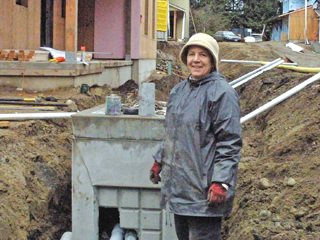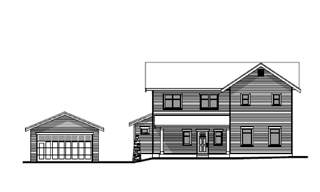|
Subscribe / Renew |
|
|
Contact Us |
|
| ► Subscribe to our Free Weekly Newsletter | |
| home | Welcome, sign in or click here to subscribe. | login |
Architecture & Engineering
| |
January 4, 2010
Martha Rose reassesses her business to find financing
Journal Staff Reporter
In September, builder Martha Rose of Martha Rose Construction found financing for a four-house project called Fish Singer Place. But getting bank approval in tough times meant she had to look at her business in a very different way.
Rose has been called the “queen of green” and has a long track record of being on the cutting edge of successful eco-friendly home developments in the Seattle area. It was her dedication to green building, she said, that eventually helped her land support from Sound Community Bank. “When I went to close my loan with the bank, I asked if my being a green builder had anything to do with the final agreement. He said it had everything to do with it (and) that had I not been a green builder, they would not have given me the money.”
It all began about a year ago when Rose planned to move ahead with the four-home project in Shoreline and the bank, with which she had a loan commitment, called and said they were withdrawing the offer. “That was sort of the beginning of the new way,” she said.
To find new financing, Rose went through a vigorous process. To start with, she hired Adrian Willanger of Eco-Redux to help find her footing in a new economy. Together, they tweaked Rose's business plan and developed a marketing plan that showed viewers who Rose was and what kind of projects she created.
Willanger said it was a big change. “Prior to doing this, she had never had to do (a business plan) before. You just went in with your blueprints, cost and went over what it would cost to build a house,” he said.
The marketing plan was a big change. Before, Rose began marketing projects after they were complete. This time, Rose hired an out-of-town marketer to make the project look fresh and help it stand out from the crowd. There are also project tours during construction and lectures and seminars held on site to engage possible buyers. The Web site was also launched earlier.
Immediately, Rose and Willanger began presenting the information to banks in meetings that would sometimes last two hours. Separately or together, Willanger and Rose went to 10 different banks and returned multiple times to some that showed potential. Rose said her interactions with bankers had been limited to 15-minute phone conversations before the recession. But finding money last year turned into a full-time job.
Educating the bankers
The majority of bank presentations were spent educating bankers on how sustainable Rose's work was. Rose said the strongest part of the market is hard-core green housing, so bankers were interested in Fish Singer Place's green credibility.
They started seeing banks in March. It took until September to find financing. “I don't think it's an exaggeration to say it's at least four to five times harder for everything, starting with the money,” Rose said.
Fish Singer Place is four homes on Dayton Avenue North, one of which includes a separate carriage house. They will be five-star Built Green and are striving to achieve net zero energy use. Houses range from 2,000 to 2,400 square feet and cost between $638,000 and $658,000. The unit with a 525-square-foot carriage house will cost $788,000. Rose said carriage houses typically rent for $1,000 a month in similar developments.
A number of techniques in the building came from the Passive House method, a cost-effective system for designing and constructing very low-energy buildings. It has very high insulation, and windows that are four times above state energy code. Buildings are blower-door tested to detect air leaks. Houses will use post lights rather than mounted lights outside to reduce penetrations in exterior walls.
Houses are pre-wired for photovoltaics and have rain cisterns for irrigation. Rainwater will filter through pervious concrete before being held in a gravel basin under the roadway where it can slowly evaporate and seep into the ground. Three of the houses will have green roofs. Rose said people want homes that aren't “phony green” so it's important to continue improving. “They want the real deal,” she said. “A house that operates like a Prius.”
Cutting overhead
For Rose, the point of green building is to constantly improve the product and to learn. For example, her team has always used locally sourced materials but now she's getting obsessive about it, she said. The team will no longer use products from Simpson Door Co., even though it is a local company, because products are made in China. Now, she will use doors from a factory near Bellingham.
The Fish Singer houses will cost less than Rose's previous houses while having more green features. Rose has cut overhead, received lower prices from some subs and is being smarter and more efficient about building decisions. “(It's) five times as much work for half as much money right now,” she said. “But what are you going to do if you're not building? Sitting at home wishing you were building.”
The project began last summer and will be finished this spring. However, the construction process was anything but ordinary. After being rejected 15 times by different banks, partially because the project had no pre-sales, Rose decided to take matters into her own hands. Rose already owned the land. She sold a 10-year-old townhome for less than it was worth so she could have cash to start putting in garages and building their foundations at Fish Singer.
The decision paid off because Sound Community Bank called in late July and said it wanted to look at the site the next day. The bankers were blown away, Rose said, because they saw she had enough confidence in the project to start it herself. They decided to finance the project. “Making that decision was the best thing that I ever did.”
However, the loan was contingent on appraisals and didn't close until September. Rose kept moving on the project, even though her funds were mostly used up. Subcontractors knew their paychecks would come when the bank loan closed, Rose said. Even though it wasn't ordinary, she said it got people off the couch and gave them work.
Rose believes this way of preparing for projects is the future and builders doing nothing need to reassess where they stand. “When people say they're going to wait until things get back, they're not gonna get back and those people are going to be waiting a very long time.”
For more information, visit www.martharoseconstruction.com/forsale/fishsingerplace/splash/.
Katie Zemtseff can be
reached by email or by phone
at (206) 622-8272.




